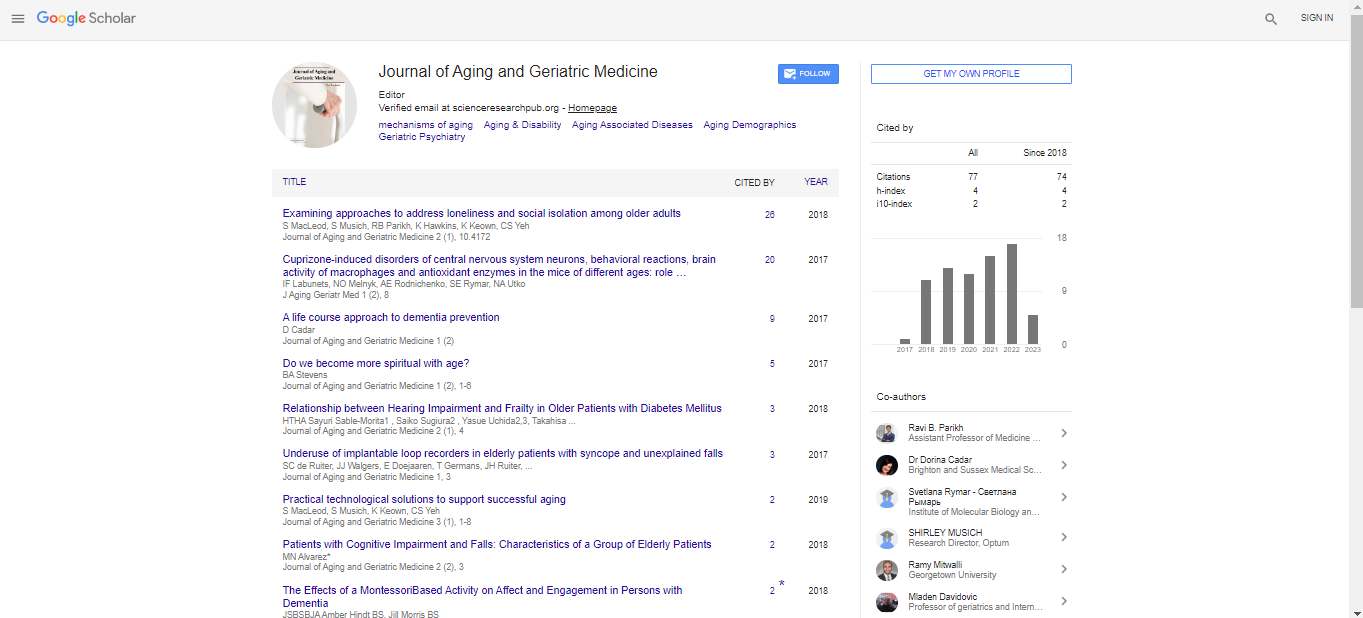Perspective, J Aging Geriatr Med Vol: 5 Issue: 6
The Undifferentiated Frame of A Normal Filamentous Fungus
Harvey L Sterns*
Department of Life-Span Development and Gerontology, The University of Akron, Akron, USA
*Corresponding Author:Harvey L Sterns
Department of Life-Span Development and Gerontology, The University of Akron, Akron, USA
E-mail:lifespan@uakron.edu
Received: June 04, 2021; Accepted: June 21, 2021; Published: June 28, 2021
Citation: Sterns HL (2021) The Undifferentiated Frame of A Normal Filamentous Fungus. J Aging Geriatr Med 5:6.
Abstract
The undifferentiated frame of a normal filamentous fungus is the mycelium, a complicated community of branched tubular cells referred to as hyphae. In most fungi, those are partitioned into wonderful mobile booths through inner pass-walls, the septae. Hypha compartments are nonstop with one another because of the incidence of septal pores, which allow the intercellular waft of cytoplasm, inclusive of organelles, ensuring the fast translocation of nutrients throughout colony established order and facilitating the preservation of cell homeostasis at some point of mycelia boom. However, this ability of the mycelium to characteristic as an included syncytium-like organism exposes it to a number of dangers, e.g., excessive cytoplasmic leakage upon hypha wounding or uncontrolled spread of selfish genetic factors together with mycoviruses, transposable elements, and senescence plasmids following vegetative hypha fusion. Therefore, the intercompartmental traffic in hyphae has to be fairly regulated so that it will protect the mycelium from such dangers, as well as to permit cellular heterogeneity and differentiation at some point of developmental strategies. Early studies in various ascomycetes implicated a specialized membrane-sure vesicle described as Warning body (WB) in sealing of septal pores to prevent cytoplasmic loss in response to hypha harm. It turned into later shown that WBs are concerned inside the manipulate of intercellular communique and the upkeep of hypha heterogeneity.
Keywords: Filamentous Fungus
Introduction
The undifferentiated frame of a normal filamentous fungus is the mycelium, a complicated community of branched tubular cells referred to as hyphae. In most fungi, those are partitioned into wonderful mobile booths through inner pass-walls, the septae. Hypha compartments are nonstop with one another because of the incidence of septal pores, which allow the intercellular waft of cytoplasm, inclusive of organelles, ensuring the fast translocation of nutrients throughout colony established order and facilitating the preservation of cell homeostasis at some point of mycelia boom. however, this ability of the mycelium to characteristic as an included syncytium-like organism exposes it to a number of dangers, e.g., excessive cytoplasmic leakage upon hypha wounding or uncontrolled spread of selfish genetic factors (together with mycoviruses, transposable elements, and senescence plasmids) following vegetative hypha fusion. Therefore, the intercompartmental traffic in hyphae have to be fairly regulated so that it will protect the mycelium from such dangers, as well as to permit cellular heterogeneity and differentiation at some point of developmental strategies. Early studies in various ascomycetes implicated a specialized membrane-sure vesicle described as Warning body (WB) in sealing of septal pores to prevent cytoplasmic loss in response to hypha harm. It turned into later shown that WBs are concerned inside the manipulate of intercellular communique and the upkeep of hypha heterogeneity. Woronin bodies that are completely observed in Pezizomycotina originate from peroxisomes, and their biogenesis requires multiple proxies. They appear in electron microscopy photos as electron-dense vesicles that are usually localized in near proximity to the septae, and they're hastily tethered to the septal pore via interacting proteins following hypha wounding. As a minimum 17 septal pore-related WBrelated proteins were detected by means of mass spectrometry in Neurospora crassa. The protein Hex1 become first characterized in N. crassa because the principal aspect of WBs. This protein spontaneously self-assembles into hexagonal crystals that comprise the dense middle of WBs. Conserved homologs of the hex1 gene were identified and studied in several contributors of the Pezizomycotina. The gene probably resulted from duplication of the ancestral gene encoding the eukaryotic initiation factor 5A (eIF-5A). After this duplication, hex1 observed a exceptional evolutionary trajectory that brought about a brand new function through obtaining the ones amino acids which might be answerable for its peroxisome focused on and self-assembly. Hex1 genes keep a conserved intron near their N-terminus, and alternative splicing of this intron has been proven to produce isoforms of the protein. Deletion of hex1 in several fungi normally brought about excessive hypha bleeding after wounding, as well as had pleiotropic results on additional phenotypes related to vegetative increase, asexual reproduction, and stress reaction in opposition to osmotic and mobile wall-perturbation marketers. Regarding pathogenicity and virulence, conflicting effects have been accumulated from research on plant, insect, and human pathogens. those variety from critical roles of Hex1 inside the formation of aspersoria (infection structures) and pathogenicity in Magnaporthe grilse to reasonably decreased or not on time virulence in Fusarium graminearum , Aspergillums flatus , and A. fumigates , and no significant defects in pathogenicity of Colletotrichum orbicular and Metarhizium Roberti The ascomycetes Verticillium dahlia reasons a wilt sickness on a wide range of commercially essential plants and vegetation, and it is chargeable for sizeable annual monetary losses international . Its resting structures, that could remain feasible in the soil for numerous years, germinate upon induction by exudates from adjoining plant roots to form hyphae. This is accompanied by way of root penetration and colonization, main the fungus to the host vascular system, through which it may cause systemic infection of the plant. Besides for the apical cells of its mycelium, hypha compartments of V. dahlia are often septae, and, upon hypha injury, WBs unexpectedly plug the pores of the flanking septae to seal broken compartments. This fungus is concept to completely lack a sexual level and, accordingly, propagates solely via the dispersion of its asexual spores.
 Spanish
Spanish  Chinese
Chinese  Russian
Russian  German
German  French
French  Japanese
Japanese  Portuguese
Portuguese  Hindi
Hindi 